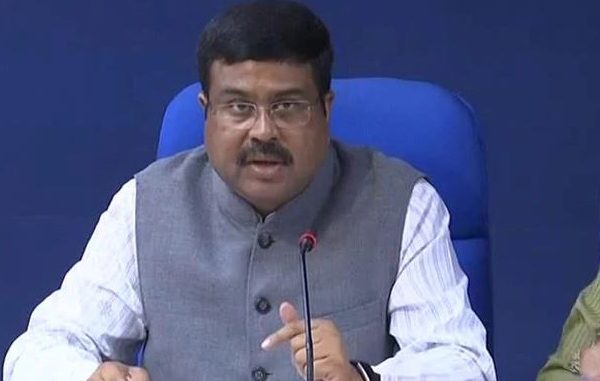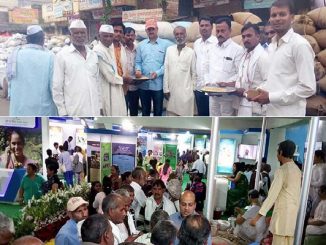
Dec 30: There has been surplus production of sugar in the country since sugar season 2010-11 (except reduction due to drought in sugar season 2016-17); & sugar production is likely to remain surplus in the country in coming years due to the introduction of improved varieties of sugarcane. In the normal sugar season (October- September) about 320 Lakh Metric Tonnes (LMT) of sugar is produced whereas, our domestic consumption is about 260 LMT. This surplus sugar of 60 LMT in normal sugar season put pressure on domestic ex-mill prices of sugar. The excess stocks of 60 LMT which remain unsold also block funds of sugar mills to the tune of about Rs. 19,000 crore thereby affecting liquidity positions of sugar mills resulting in accumulation of cane price arrears of farmers. To deal with surplus stocks of sugar, sugar mills have been exporting sugar, for which Government has been extending financial assistance. Moreover, India being a developing country can export sugar by extending financial assistance only up to year 2023 as per WTO arrangements.
So, diversion of excess sugarcane & sugar to ethanol is a correct way forward to deal with surplus stocks. Diversion of excess sugar would help in stabilizing the domestic ex-mill sugar prices and will also help sugar mills to get relieved from storage problems. It will improve their cash flows and facilitate them in clearance of cane price dues of farmers; and will facilitate mills to function in the coming years.
Government has fixed target of 10% blending of fuel grade ethanol with petrol by 2022, 15% blending by 2026 & 20% blending by 2030. With a view to support sugar sector and in the interest of sugarcane farmers, the Government has also allowed production of ethanol from B-Heavy Molasses, sugarcane juice, sugar syrup and sugar; and has been fixing the remunerative ex-mill price of ethanol derived from C-heavy molasses, B-heavy molasses and ethanol derived from sugarcane juice/ sugar/ sugar syrup for ethanol season. For ethanol supply year 2020-21, Government has now increased the ex-mill price of ethanol derived from various feed stocks.
To increase production of fuel grade ethanol, Govt. is also encouraging distilleries to produce ethanol from maize; & rice available with FCI. Government has fixed remunerative price of ethanol from maize & rice.
Government is also planning to prepone achievement of 20% blending target by year 2025 and onwards. However, the existing ethanol distillation capacity in the country is not sufficient to divert surplus stocks of sugar & to produce ethanol to supply to Oil Marketing Companies (OMCs) for blending with petrol as per the blending targets fixed by Government of India.
Further the blending targets cannot be achieved only by diverting sugarcane / sugar to ethanol; & 1st Generation (1G) ethanol is required to be produced from other feed stocks like grains, sugar beet etc for which the present distillation capacity is also not sufficient. Therefore, it is an imperative need to enhance ethanol distillation capacity in the country for producing 1st Generation (1G) ethanol from feed stocks such as cereals (rice, wheat, barley, corn & sorghum), sugarcane, sugar beet etc.
Hence, the Government has taken following decisions:
To bring a modified scheme for extending interest subvention to augment ethanol production capacity for following categories:
Setting up grain based distilleries / expansion of existing grain based distilleries to produce ethanol. However, benefits of interest subvention scheme to be extended to only those stand alone distilleries which are using dry milling process.
Setting up new molasses based distilleries / expansion of existing distilleries (whether attached to sugar mills or standalone distilleries) to produce ethanol and for installing any method approved by Central Pollution Control Board for achieving Zero Liquid Discharge (ZLD).
To set up new dual feed distilleries or to expand existing capacities of dual feed distilleries.
To convert existing molasses based distilleries (whether attached to sugar mills or standalone distilleries) to dual feed (molasses and grain/ or any other feed stock producing 1G Ethanol); and also to convert grain based distilleries to dual feed.
To set up new distilleries / expansion of existing distilleries to produce ethanol from other feed stocks producing 1G ethanol such as sugar beet, sweet sorghum, cereals etc.
To install Molecular Sieve Dehydration (MSDH) column to convert the rectified spirit to ethanol in the existing distilleries.
Government would bear interest subvention for five years including one year moratorium against the loan availed by project proponents from banks @ 6% per annum or 50% of the rate of interest charged by banks whichever is lower.
Interest subvention would be available to only those distilleries which will supply at least 75% of ethanol produced from the added distillation capacity to OMCs for blending with petrol.
Proposed intervention would enhance production of 1G ethanol from various feed stocks thereby, facilitate in achieving blending targets of ethanol with petrol and would promote ethanol as a fuel which is indigenous, non-polluting and virtually inexhaustible and would improve the environment and the ecosystem and result in savings on Oil Import Bill. It will also ensure timely payment of dues to farmers.
Achievement of Government in past six years in increasing distillation capacity & blending levels
The Government has fixed a target of 10% blending of ethanol into motor fuel by 2022 and 20% by 2030. Till year 2014, ethanol distillation capacity of molasses based distilleries was less than 200 crlitres. However, in past 6 years the capacity of molasses based distilleries have been more than doubled and are currently at 426 crlitres. With a view to achieve blending targets, Govt. is making concerted efforts to further double the ethanol distillation capacities in the country by 2024.
In ethanol supply year (ESY) 2013-14, supply of ethanol to OMCs was less than 40 crore litres with blending levels of only 1.53 %. However, due to concerted efforts of Central Government, production of fuel grade ethanol and its supply to OMCs has increased by more than 4 times in the past 6 years. In ESY 2018-19, we touched a historically high figure of about 189 crlitres thereby achieving 5% blending. However, due to drought in some regions of Maharashtra and Karnataka, production of sugar and consequently molasses was lower in sugar season 2019-20 and therefore, only about 172.50 crlitres of ethanol were supplied by distilleries to OMCs in ESY 2019-20 to achieve 5% blending. It is expected that in current ethanol supply year 2020-21, about 325 crltrs ethanol is likely to be supplied to OMCs to achieve 8.5 % blending levels. It is likely that we will be achieving 10% blending target by 2022.
With the increase in blending levels, dependence on imported fossil fuel will decrease and will also reduce air pollution. Also due to upcoming investment in capacity addition/new distilleries, various new employment opportunities will also be created in rural areas; thereby, realizing the goal of Atmanirbhar Bharat.
Disclaimer: We donot claim that the images used as part of the news published are always owned by us. From time to time, we use images sourced as part of news or any related images or representations. Kindly take a look at our image usage policy on how we select the image that are used as part of the news.


